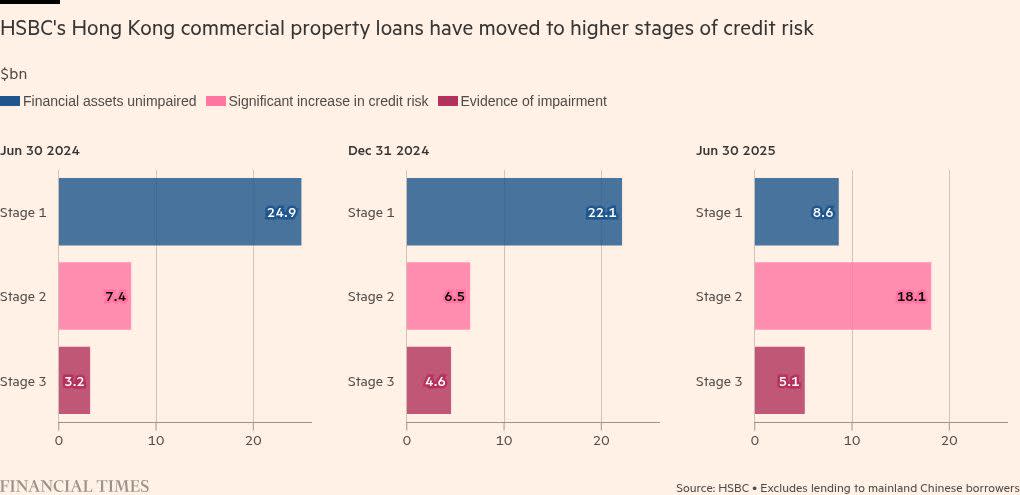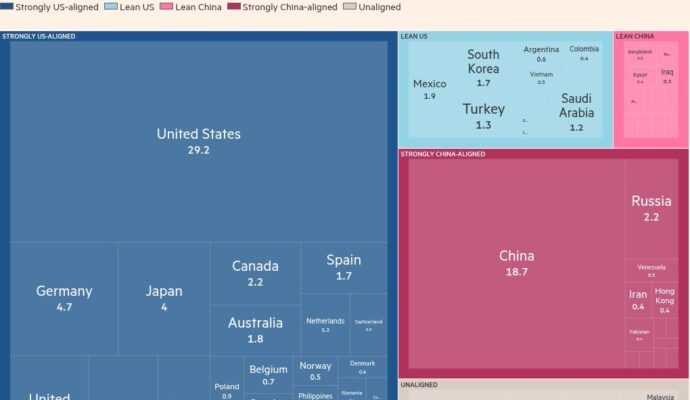Unlock the Editor’s Digest for free
Roula Khalaf, Editor of the FT, selects her favourite stories in this weekly newsletter.
Almost three-quarters of HSBC’s Hong Kong commercial property loan book was flashing warning signs by the end of June, as a prolonged slump in retail spending and sluggish demand for office space weigh on Europe’s largest bank.
HSBC is Hong Kong’s largest lender and the territory is the single largest source of income for the bank by geography. HSBC $32bn of commercial real estate loans in the territory, out of a $234bn Hong Kong loanbook.
Hong Kong’s prime office rents have fallen more than 20 per cent since 2022, and vacancy rates are at record highs of about 19 per cent, according to commercial real estate group Cushman & Wakefield.
The bank said the amount of Hong Kong commercial real estate loans marked as bearing increased credit risk had almost tripled since the start of the year, from $6.5bn to $18.1bn, after it updated an internal model that predicts the probability of a borrower defaulting.
Although loans at greater credit risk are still performing, those considered “impaired” also increased, from $4.5bn to $5.1bn.
“Banks are now more aggressive in clearing up their non-performing loans this year. [In the second] quarter, we [see] about half of the transactions are financially stressed,” said Reeves Yan, head of capital markets at CBRE.
The jump means that 73 per cent of HSBC’s Hong Kong commercial real estate loans are either impaired or marked as having increased credit risk, up from less than 30 per cent a year ago. HSBC put aside $1.1bn for expected credit losses in the second quarter, of which $400mn was for Hong Kong commercial real estate exposure.
“Clearly, there are a number of stressed real estate companies in Hong Kong . . . it is definitely flashing significant warning signs and has done so for a while,” said Michael Makdad, an Asian financial analyst at Morningstar.
Historic family conglomerate developers such as New World Development, which pulled off an $11bn refinancing at the end of June, have been the focus of much of the stress in the local real estate market.
Big developers have written down the value of their property portfolios by billions of dollars in recent years during a market downturn.
But much of HSBC’s pain is within Hang Seng Bank, its local Hong Kong lender, which analysts said had a higher proportion of loans to smaller real estate developers and players, some of which are now experiencing acute financial difficulties.
Hang Seng’s non-performing loan ratio stood at 6.7 per cent at the end of June, the highest it has ever been — including during the Asian financial crisis in 1999 — according to calculations by Goldman Sachs for the Financial Times.
Smaller Hong Kong developers have also been struggling under high debt and suppressed profits. A brief drop in the territory’s Hibor lending rate did not have a sustained benefit for real estate companies.
“The problems are with smaller and medium-sized companies in the commercial real estate space, not the diversified groups,” said Gurpreet Singh Sahi, an analyst at Goldman Sachs.
Some analysts said there was evidence that Hong Kong, which has some of the world’s most expensive real estate, was seeing its property crisis bottom out with demand recovering, citing major office transactions, including by Jane Street and the Hong Kong Exchange.
In a statement to analysts last week, HSBC chief executive Georges Elhedery said the bank’s Hong Kong real estate clients were working “through some short-term challenges”.
“But in the medium to long term, we remain confident in the supply and demand dynamic in Hong Kong and the appeal of Hong Kong real estate at large and, therefore, remain constructive and optimistic.”
Data by Haohsiang Ko



